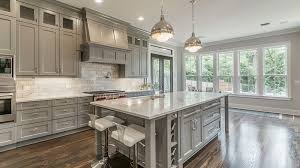Table of Contents
- Introduction to Kitchen Refacing
- Assessing Your Kitchen’s Needs
- Popular Refacing Materials
- Longevity and Durability
- Cost Considerations
- Environmental Impact
- Maintenance and Upkeep
- Conclusion
Select materials that balance durability, style, and budget when refacing your kitchen. Popular options include wood for a classic look, laminate for affordability, and thermofoil for low maintenance. Each material offers unique benefits, so choose based on your kitchen’s needs, desired aesthetics, and long-term upkeep requirements.
Introduction to Kitchen Refacing
The allure of updating a kitchen without the hassle of a complete renovation makes kitchen refacing so appealing. This process involves replacing the surface material of your existing cabinetry, offering a fresh look at a fraction of the cost and time of a complete remodel; for those looking for local solutions, cabinet refinishing St. Louis provides tailored services that meet various needs and preferences. But with myriad materials available, how do you choose the right one?
This guide discusses the importance of selecting suitable materials for kitchen refacing, highlighting the need to balance aesthetics, durability, cost, and maintenance needs. It provides a comprehensive guide on the various material options available, ensuring a choice that aligns with your kitchen’s needs and lifestyle.
Assessing Your Kitchen’s Needs
To choose suitable kitchen materials, consider your household’s lifestyle, cooking habits, and current design theme. Durability is crucial for a busy family, while a chef may prefer a material that blends aesthetics with functionality. Durability is essential for children or pets, while aesthetics may be more critical for socializing individuals. Consider the frequency of cooking, meal preparation, and daily cleanliness level. By doing so, you can choose a suitable material for your kitchen.
Popular Refacing Materials
- Laminate: It’s reasonably priced and comes in various hues and designs, making it adaptable. A sturdy and hygienic surface is produced by pressing layers of paper or cloth with resin to create laminate. It’s a popular option for those who want to achieve a stylish look without spending too much. However, it may not offer the same longevity as some other materials and can be susceptible to damage from sharp objects and high heat.
- Wood Veneer: Gives a refined and timeless appearance. It is ideal for anyone seeking a classic or rustic kitchen design. A thin natural wood coating is placed onto a substrate to create a wood veneer. It provides the beauty of wood without the high cost and can be sanded and refinished multiple times. However, it is more vulnerable to moisture and humidity, so it’s essential to maintain proper kitchen ventilation to prevent warping.
- Thermofoil: Known for its durability and smooth finish, it’s great for high-traffic kitchens. Thermofoil is a vinyl laminate heated and molded over medium-density fiberboard (MDF). It’s highly moisture-resistant and easy to clean, making it ideal for busy households. The downside is that it can peel or blister if exposed to high temperatures, so it should be kept away from heat sources like stovetops and ovens.
- Solid Wood: This is the most premium option, ideal for longevity and a high-end appearance. Solid wood cabinetry is timeless and highly durable, potentially lasting for decades if properly cared for. It is also versatile, as it can be stained or painted to match any decor. Maintaining its quality and beauty costs more and requires more frequent upkeep.
Longevity and Durability
The lifespan of a kitchen refacing depends on the material and installation quality. Solid wood and high-quality veneers offer the best durability, lasting decades when properly maintained. Thermofoil is ideal for humid environments due to its moisture resistance, while wood veneer is suitable for less humid areas. Choose a material that can withstand spills, stains, and scratches. A professional and precise installation can extend the project’s lifespan, preventing issues like peeling or chipping. Overall, durability is crucial for a successful kitchen refacing project.
Cost Considerations
The choice of material depends on your budget, with laminate and thermofoil being more cost-effective. Wood veneers and solid wood are more expensive, but their durability and aesthetic appeal are worth it. Consider the cost of ongoing upkeep because solid wood has long-term advantages like refinishing and restoration, but it may demand a more significant initial expenditure. Laminate and thermofoil are cheaper initially but may require more frequent replacements or touch-ups. Therefore, consider both cost and benefits when selecting a material.
Environmental Impact
Eco-conscious homeowners consider the environmental impact of materials when refacing their kitchen. Materials like certified sustainable wood and low-VOC laminates can reduce carbon footprints. HowStuffWorks offers eco-friendly remodeling options that align with environmental values. Selecting sustainably sourced materials like FSC-certified wood ensures responsibly managed forests, while low-VOC or no-VOC laminates and adhesives improve indoor air quality. Recycling old materials and proper waste disposal also contribute to a more sustainable refacing project.
Maintenance and Upkeep
Different materials require different levels of upkeep, such as solid wood requiring regular polishing and scratches and laminate and thermofoil being low-maintenance. Understanding the maintenance required can help make an informed decision. A refaced kitchen’s durability and attractiveness depend heavily on routine maintenance. Wood surfaces should be cleaned with wood-specific products to avoid damaging the finish, while thermofoil cabinets can be cleaned with soap and water, making them convenient for busy households. Dedicating time to maintenance is essential for a kitchen’s longevity and appearance.
Conclusion
Balancing aesthetics, durability, cost, and maintenance is crucial for kitchen refacing. By assessing your kitchen’s needs and considering the pros and cons of each material, you can achieve a stunning transformation that meets both functional and aesthetic requirements. With thoughtful planning, your refaced kitchen will look refreshed and last.

